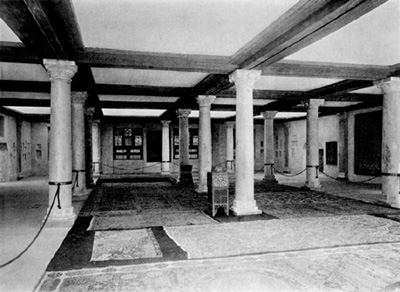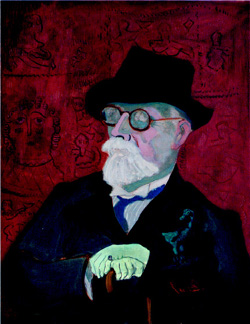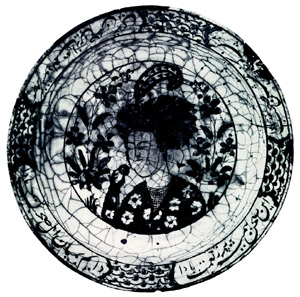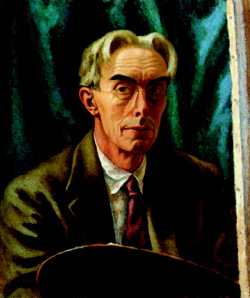IRANICA: FRAGMENTATION: ESSAY
Commercial excavation was only one of the diverse modes by which medieval Iranian artifacts were transmitted to Western audiences. Beginning in the late nineteenth century, wall-tiles with epigraphic or figural decorations were removed from the mosques, shrines, and ruined palaces of Iran and sold to Western collectors. In 1881, the French traveler Jane Dieulafoy visited the Imamazda Yahya, a shrine in Varamin, and reported that “parts of its revetment have been stripped and sold in Tehran at some rather high prices.”1 Many of the Shi’i shrines of Qum were decorated with tiles manufactured during the Ilkhanid dynasty (ca. 1220-1340). These tiles were moved first in the fourteenth century, when they were stripped from secular structures to supply ornament for the newly-built shrines. Therefore the depredations of the nineteenth century represented in fact a second wave of dislocation, albeit one that resulted in greater geographic dispersal of material than the first.2 A full tile of the same type as the phoenix tile shown here ended up in the collection of the Italian poet Gabriele d’Annunzio.3
The dismemberment of manuscripts is not as well documented as the dispersal of architectural tiles. We do not know the name or the dates of the first collector who excised a miniature, framed it, and hung it on the wall. Such an act would not have been out of place in nineteenth-century Iran, where Western-style panel painting had come into vogue. Certainly by the mid-nineteenth century, a number of such detached miniatures had made their way into European collections. Hagop Kevorkian’s 1914 New York exhibition of his collection included over 250 “miniature paintings,” some of which had been conceived as autonomous works of art, but most of which were fragments of books.4 Kevorkian himself described “his desire to find the book from which some of the pictures in his collection had been cut.”5
Most of these acts of dismemberment may be explained by greed. Fragmentation turned architectural elements into portable commodities, and converted single manuscripts into multiple paintings. In a curious confluence of economic and cultural history, however, the fragmentation of architectural decoration and manuscripts, which had already begun by the late nineteenth century, found retrospective justification in the philosophical discourse of modernism.
The 1910 Exhibition of Masterpieces of Muhammedan Art, held in Munich in 1910, marks a crucial moment in the translation of Islamic objects into Western objets d’art.6 Previous exhibitions of Islamic art had presented objects in dense assemblages intended to evoke Western fantasies of “the Orient” – “the Sultan’s harem” and the like.7 The Munich show, by contrast, employed the modernist exhibition techniques of the various European Secessionist movements. As one of the organizers, the collector and scholar Friedrich Sarre (1865-1945), wrote, the objects were placed on “white, unornamented walls” without “fantastic assemblages” in an “effort to allow the art works to function solely by means of their quality.”8 Thus the Munich show, instead of creating a new, artificial composite out of various fragments, presented the fragments themselves as self-sufficient “art works.”

The Exhibition of Masterpieces of Muhammedan Art, Munich, 1910.
"The halls, designed in contemporary fashion, were not always well received; with their white, unornamented walls, the exhibition did not follow traditional principles. All this may have been emphasized somewhat crudely: one exhibition organizer declared war against the popular understanding of Oriental art, against the fairytale splendor and bazaar commodities."
Friedrich Sarre, Die Ausstellung von Meisterwerken muhammedanischer Kunst (Munich, 1910).
The transformation of Islamic objects from elements in theatrical Orientalist fantasies into autonomous works of art is mirrored in the writings of Dikran Kelekian. In 1899, Kelekian had been advertising his wares in frankly commercial and fantastic terms:
His shop is a veritable museum, but one supplied with a constant succession of new objects fresh from the inexhaustible East, or from the great collections that yearly come under the auctioneer’s hammer… To visit Kelekian’s is to live an hour in the enchanted atmosphere of the Arabian nights.9
Ten years later, in his short pamphlet on the Potteries of Persia, Kelekian was shifting his attention, and thereby also the focus of his customers, away from Eastern luxury and toward formal design:
The artists who contributed to the luxury of the Persian potentates were as genuinely gifted as any that ever lived. Certainly, they had a wonderfully acute and refined sense of color, and the harmonious color combinations in their carpets, their textiles and their potteries is their particular and personal contribution to the progress of art… The Persian art is nearer to the spirit of the time in which we live [than the Greek and the Egyptian]. It is more human than its predecessors.10
By 1910, when Kelekian issued his lavish folio publication of The Kelekian Collection of Persian and analogous potteries, the transformation was complete. Here the insistence on the artistic value of Iranian ceramics is almost obsessive: they “bear every indication of having been created as works of art”; they are “rarely pleasing artistic objects.” Finally:
My object in selecting the specimens which make up my collection has been to establish the right of the Persian potteries to be regarded as one of the powerful artistic impulses of all time. No artists of any epoch have so fully understood the principles of decoration, and their works, the few of them which have come down to us, are a lasting monument to their skill. Persian art is Decoration in its highest interpretation. The day when it will receive its full meed of appreciation and understanding is not, I am convinced, far distant. It only remains for the beautiful potteries to be recognized as the lovely works of art they undoubtedly are, for their beauty and their charm to be felt. Classified, as I have attempted to arrange them in my collection, they present a logical and luminous study, as convincing as a collection of Italian paintings might be from the days of Giotto to the decline of the Renaissance…. [If this book] succeeds in presenting these beautiful works in such a fashion as to make them better known and appreciated, I shall feel that my labors have not been in vain.11

Dikran Kelekian, painted by Milton Avery. "He was one of the first persons in the world to hail the modernists and recognize that their style was a revival of the age-old conventions of Islam."
Art News, 15-31 Oct 1944.
Kelekian’s goal, in short, was to present the history of Persian art as a coherent narrative of birth, development, and decline, explicitly on the Vasarian model of the Italian Renaissance. However, whereas the Italian artists had developed the perspectival rendering of visual perceptions, their Persian peers had developed “Decoration in its highest interpretation.” By asserting the equivalence of the two traditions, Kelekian was giving bold support to the modernist rejection of academic painting. Indeed, Kelekian had almost certainly by this time begun to assemble his own collection of modern French art.12 As an Art News journalist wrote in 1944, he was “one of the first persons in the world to hail the modernists and recognize that much of their style was in reality a revival of the age-old conventions of Islam.”13
The plates that constitute the bulk of the Kelekian Collection all display a single geometrical figure—usually a circle—placed against a white ground. The vessels and tiles are all photographed from an uncompromising, frontal perspective that serves to flatten them, transforming each into a formal essay executed on a two-dimensional plane. It was only thus, abstracted from real space, that Iranian ceramics could be understood as the precursors to modernist panel paintings. In order for Persian art to be set up as a “fine art” tradition analogous to that of the Renaissance, it was necessary for it to adopt the veil of Western design – in short, for it to become a system of formal relationships within discrete plane surfaces.14

"Portrait plate" from the Kelekian Collection
"Classified, as I have attempted to arrange them, Persian ceramics present a logical and luminous study, as convincing as a collection of Italian paintings from the days of Giotto to the decline of the Renaissance"
Dikran Kelekian, The Kelekian collection of Persian and analogous potteries (Paris, 1910).
Indeed, while a number of reviews of the Munich show lamented its lack of Orientalist ambience, a few significant modernist painters and critics responded with enthusiasm.15 Roger Fry (1866-1934) devoted two essays in The Burlington Magazine to formal analyses of various objects in the exhibition, and characterized the sum effect as that of “an art in which the smallest piece of pattern-making shows a tense vitality even in its most purely geometrical manifestations.”16 Henri Matisse (1869-1954) made a trip to Munich specifically to see the exhibition; he was deeply impressed and soon afterward set off for the Alhambra.17 Wassily Kandinsky (1866-1954), who was living in Munich in 1910, saw the miniatures in the Exhibition of Muhammedan Art as exemplars of artistic freedom, in which
…not only perspective but also “naturalness” are calmly set at naught. In these breathtaking compositions, everything that art needs, even today, is treated freely, purposefully, while the superfluous is set aside with equal freedom, simplicity, and naturalness…. This is that artistic freedom for which we seek today with a lighted torch….18
From the ruins of Rayy, via the shops of Kelekian and Kevorkian, to the high-theoretical ruminations of Fry and Kandinsky: an act of translation has occurred here. The paintings and ceramics of medieval Iran, which once were objects with spatially determinate roles within domestic, architectural, or literary ensembles, have become autonomous works of art.

Roger Fry, self-portrait. "Principles precisely similar to those employed by Persian potters are being put into practice by the present geneartion."
Burlington Magazine, Dec 1920.
This account of Islamic art as a series of proto-modernist formal exercises, having crystallized around 1910, set the tone for a generation of criticism. Still in 1930, Roger Fry was perceiving in Matisse’s painting “the gift that we note in almost all Mahomeddan art, the gift of finding rich new and surprising harmonies of colour notes placed in apposition upon a flat surface.”19 Fry was no longer speaking as a dilettante; he had in fact been commissioned by Arthur Upham Pope to write the final chapter of the latter’s monumental Survey of Persian Art.20 Pope himself, who did more than any other scholar in the first half of the twentieth century to promote the study of medieval Iranian art, was an erstwhile professor of aesthetics whose appreciations of things Persian were deeply marked by the language of Western philosophy. In 1931 he defined the “achievement” of Persian art with a single proposition: “Great design has the authority of logic.”21
BWA